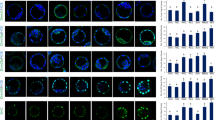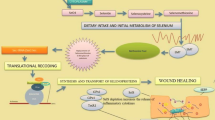Abstract
Selenium (Se) is a trace element for human and animal health. Cadmium (Cd) is a known human carcinogen. The effects of Cd on the environment and humans are well known. Because chickens are at the top of the food chain, it is a good experimental animal model for assessing heavy metal toxicity and its potential threat to humans. Selenomethionine (Se-met) is a suitable form for nutritional Se supplementation. Therefore, the toxicity of Cd to the chicken liver and the antagonistic effects of Se-met on Cd were examined at the molecular level in the present study. The results showed that oxidative stress indicators (apoptosis-related genes, P13K/AKT pathway–related genes, and heat shock proteins (HSPs)–related genes) in the Cd group have changed significantly, indicating Cd induced hepatocyte stress and apoptosis. Interestingly, the changes in oxidative stress indicators (apoptosis-related genes, P13K/AKT pathway–related genes, and HSPs-related genes) in the Cd-Se-met group were mitigated compared with the control group. Our results indicated that Cd can induce hepatocyte apoptosis and stress in the chickens. Se-met has an ameliorative effect on Cd-induced apoptosis of chicken hepatocyte by regulating PI3K/AKT pathway. Our findings will provide a new insight for better understanding of the detoxification function of Se-met to heavy metals.






Similar content being viewed by others
References
Zhang Z, Zheng Z, Cai J, Liu Q, Yang J, Gong Y, Wu M, Shen Q, Xu S (2017) Effect of cadmium on oxidative stress and immune function of common carp (Cyprinus carpio L.) by transcriptome analysis. Aquat Toxicol 192:171–177
Chen J, Xu Y, Han Q, Yao Y, Xing H, Teng X (2019) Immunosuppression, oxidative stress, and glycometabolism disorder caused by cadmium in common carp (Cyprinus carpio L.): application of transcriptome analysis in risk assessment of environmental contaminant cadmium. J Hazard Mater 366:386–394
Wei Y, Zheng X, Shohag MJI, Gu M (2017) Bioaccessibility and human exposure assessment of cadmium and arsenic in pakchoi genotypes grown in co-contaminated soils. Int J Environ Res Public Health 14(9):977–993
Ataei N, Aghaei M, Panjehpour M (2019) Evidences for involvement of estrogen receptor induced ERK1/2 activation in ovarian cancer cell proliferation by cadmium chloride. Toxicol in Vitro 56:184–193. https://doi.org/10.1016/j.tiv.2019.01.015
Chen QY, DesMarais T, Costa M (2019) Metals and mechanisms of carcinogenesis. Annu Rev Pharmacol Toxicol 59:537–554. https://doi.org/10.1146/annurev-pharmtox-010818-021031
Jin X, Jia T, Liu R, Xu S (2018) The antagonistic effect of selenium on cadmium-induced apoptosis via PPAR-γ/PI3K/Akt pathway in chicken pancreas. J Hazard Mater 357:355–362
Qu KC, Wang ZY, Tang KK, Zhu YS, Fan RF (2019) Trehalose suppresses cadmium-activated Nrf2 signaling pathway to protect against spleen injury. Ecotoxicol Environ Saf 181:224–230
Akahoshi N, Anan Y, Hashimoto Y, Tokoro N, Mizuno R, Hayashi S, Yamamoto S, Shimada K, Kamata S, Ishii I (2019) Dietary selenium deficiency or selenomethionine excess drastically alters organ selenium contents without altering the expression of most selenoproteins in mice. J Nutr Biochem 69:120–129
Yao HD, Wu Q, Zhang ZW, Zhang JL, Li S, Huang JQ, Ren FZ, Xu SW, Wang XL, Lei XG (2013) Gene Expression of endoplasmic reticulum resident selenoproteins correlates with apoptosis in various muscles of Se-deficient chicks. J Nutr 143(5):613–620
Sun Z, Xu Z, Wang D, Yao H, Li S (2018) Selenium deficiency inhibits differentiation and immune function and imbalances the Th1/Th2 of dendritic cells. Metallomics 10(5):759–767. https://doi.org/10.1039/c8mt00039e
Yang T, Cao C, Yang J, Liu T, Lei XG, Zhang Z, Xu S (2018) miR-200a-5p regulates myocardial necroptosis induced by Se deficiency via targeting RNF11. Redox Biol 15:159–169
Chi Q, Luan Y, Zhang Y, Hu X, Li S (2019) The regulatory effects of miR-138-5p on selenium deficiency-induced chondrocyte apoptosis are mediated by targeting SelM. Metallomics 11:845–857
Krysiak R, Okopień B (2011) The effect of levothyroxine and selenomethionine on lymphocyte and monocyte cytokine release in women with Hashimoto’s thyroiditis. J Clin Endocrinol Metab 96:2206–2215
Krysiak R, Kowalcze K, Okopień B (2019) Selenomethionine potentiates the impact of vitamin D on thyroid autoimmunity in euthyroid women with Hashimoto’s thyroiditis and low vitamin D status. Pharmacol Rep 71:367–373
Santra D, Sen K (2019) Generating cellulose-agar composite hydrogels for uptake-release kinetic studies of selenate and selenomethionine. Int J Biol Macromol 122:395–404
Toulis KA, Anastasilakis AD, Tzellos TG, Goulis DG, Kouvelas D (2010) Selenium supplementation in the treatment of Hashimoto’s thyroiditis: a systematic review and a meta-analysis. Thyroid 20:1163–1173
Wichman J, Winther KH, Bonnema SJ, Hegedüs L (2016) Selenium supplementation signicantly reduces thyroid autoantibody levels in patients with chronic autoimmune thyroiditis: a systematic review and meta-analysis. Thyroid 26:1681–1699
Fu J, Yang T, Wang W, Xu S (2019) Effect of selenium antagonist lead-induced damage on Th1/Th2 imbalance in the peripheral blood lymphocytes of chickens. Ecotoxicol Environ Saf 175:74–82
Rahman MM, Uson-Lopez RA, Sikder MT, Tan G, Hosokawa T, Saito T, Kurasaki M (2018) Ameliorative effects of selenium on arsenic-induced cytotoxicity in PC12 cells via modulating autophagy/apoptosis. Chemosphere 196:453–466
Agnihotri SK, Agrawal U, Ghosh I (2015) Brain most susceptible to cadmium induced oxidative stress in mice. J Trace Elem Med Biol 30:184–193
Liu F, Wang XY, Zhou XP, Liu ZP, Song XB, Wang ZY, Wang L (2017) Cadmium disrupts autophagic flux by inhibiting cytosolic Ca2+-dependent autophagosome-lysosome fusion in primary rat proximal tubular cells. Toxicology 383:13–23
Chen M, Li X, Fan R, Yang J, Jin X, Hamid S, Xu S (2018) Cadmium induces BNIP3-dependent autophagy in chicken spleen by modulating miR-33-AMPK axis. Chemosphere 194:396–402
Johansen P, Mulvad G, Pedersen HS, Hansen JC, Riget F (2006) Accumulation of cadmium in livers and kidneys in Greenlanders. Sci Total Environ 372:58–63
Gong ZG, Wang XY, Wang JH, Fan RF, Wang L (2019) Trehalose prevents cadmium-induced hepatotoxicity by blocking Nrf2 pathway, restoring autophagy and inhibiting apoptosis. J Inorg Biochem 192:62–71
Xing H, Wang C, Wu H, Chen D, Li S, Xu S (2015) Effects of atrazine and chlorpyrifos on DNA methylation in the brain and gonad of the common carp. Comp Biochem Physiol C 168:11–19
Hu X, Chi Q, Liu Q, Wang D, Zhang Y, Li S (2019) Atmospheric H 2 S triggers immune damage by activating the TLR-7/MyD88/NF-κB pathway and NLRP3 inflammasome in broiler thymus. Chemossphere 237:124427. https://doi.org/10.1016/j.chemosphere.2019.124427
Kalantari H, Khodayar MJ, Saki N, Khorsandi L, Teymoori A, Alidadi H, Samimi A (2019) Microarray analysis of apoptosis gene expression in liver injury induced by chronic exposure to arsenic and high-fat diet in male mice. Environ Sci Pollut Res Int. https://doi.org/10.1007/s11356-019-05907-3
Wang S, Ren X, Hu X, Zhou L, Zhang M, Zhang C (2019) Cadmium-induced apoptosis through reactive oxygen species-mediated mitochondrial oxidative stress and the JNK signaling pathway in TM3 cells, a model of mouse Leydig cells. Toxicol Appl Pharmacol 368:37–48
Xing H, Li S, Wang Z, Gao X, Xu S, Wang X (2012) Oxidative stress response and histopathological changes due to atrazine and chlorpyrifos exposure in common carp. Pestic Biochem Physiol 103(1):74–80
Xing H, Li S, Wang Z, Gao X, Xu S, Wang X (2012) Histopathological changes and antioxidant response in brain and kidney of common carp exposed to atrazine and chlorpyrifos. Chemossphere 88(4):377–383
Hanana H, Kleinert C, André C, Gagné F (2019) Influence of cadmium on oxidative stress and NADH oscillations in mussel mitochondria. Comp Biochem Physiol C Toxicol Pharmacol 216:60–66
Ansari MN, Ganaie MA, Rehman NU, Alharthy KM, Hamad AM (2019) Protective role of roflumilast against cadmium-induced cardiotoxicity through inhibition of oxidative stress and NF-κB signaling in rats. Saudi Pharm J 27:673–681
Zheng S, Zhao J, Xing H, Xu S (2019) Oxidative stress, inflammation, and glycometabolism disorder-induced erythrocyte hemolysis in selenium-deficient exudative diathesis broilers. J Cell Physiol 234:16328–16337. https://doi.org/10.1002/jcp.28298
Xing H, Peng M, Li Z, Chen J, Zhang H, Teng X (2019) Ammonia inhalation-mediated mir-202-5p leads to cardiac autophagy through PTEN/AKT/mTOR pathway. Chemosphere 235:858–866. https://doi.org/10.1016/j.chemosphere.2019.06.235
Dkhil MA, Moneim E, Abdel AL-Quraishy S (2016) Indigofera oblongifolia ameliorates lead acetate-induced testicular oxidative damage and apoptosis in a ratmodel. Biol Trace Elem Res 173:354–361
Abu-Khudir R, Habieb ME, Mohamed MA, Hawas AM, Mohamed TM (2017) Anti-apoptotic role of spermine against lead and/or gamma irradiation-induced hepatotoxicity in male rats. Environ Sci Pollut Res 24:24272–24283
Abdel-Zaher AO, Abd-Ellatief RB, Aboulhagag NA, Farghaly HSM, Wasei FMM (2019) The interrelationship between gasotransmitters and lead-induced renal toxicity in rats. Toxicol Lett 310:39–50. https://doi.org/10.1016/j.toxlet.2019.04.012
Zheng S, Jin X, Chen M, Shi Q, Zhang H, Xu S (2019) Hydrogen sulfide exposure induces jejunum injury via CYP450s/ROS pathway in broilers. Chemosphere 214:25–34. https://doi.org/10.1016/j.chemosphere.2018.09.002
Chen W, Cui Y, Zheng S, Huang J, Li P, Simoncini T, Zhang Y, Fu X (2015) 2-Methoxyestradiol induces vasodilation by stimulating NO release via PPARγ/PI3K/Akt pathway. PLoS One 10:e0118902
Zhai Y, Lu Q, Liu Y, Cheng Q, Wei Y, Zhang F, Li C, Yin X (2013) Overproduction of nitric oxide by oxidative stress-induced activation of the TGF-β1/PI3K/Akt pathway in mesangial cells cultured in high glucose. Acta Pharmacol Sin 34:507–514
Liu S, Xu F, Fu J, Li S (2015) Protective roles of selenium on nitric oxide and the gene expression of inflammatory cytokines induced by cadmium in chicken splenic lymphocytes. Biol Trace Elem Res 168:252–260
Zhu ZC, Liu JW, Yang C, Zhao M, Xiong ZQ (2019) XPO1 inhibitor KPT-330 synergizes with Bcl-xL inhibitor to induce cancer cell apoptosis by perturbing rRNA processing and Mcl-1 protein synthesis. Cell Death Dis 10(6):395–408
He J, Mi S, Qin XW, Weng SP, Guo CJ, He JG (2019) Tiger frog virus ORF104R interacts with cellular VDAC2 to inhibit cell apoptosis. Fish Shellfish Immunol 92:889–896. https://doi.org/10.1016/j.fsi.2019.07.017
Tsai YH, Lin JJ, Ma YS, Peng SF, Huang AC, Huang YP, Fan MJ, Lien JC, Chung JG (2019) Fisetin inhibits cell proliferation through the induction of G/G phase arrest and caspase-3-mediated apoptosis in mouse leukemia cells. Am J Chin Med 47(4):1–23
Zhou BH, Tan PP, Jia LS, Zhao WP, Wang JC, Wang HW (2018) PI3K/AKT signaling pathway involvement in fluoride-induced apoptosis in C2C12 cells. Chemosphere 199:297–302
Xing H, Li S, Wang X, Gao X, Xu S, Wang X (2013) Effects of atrazine and chlorpyrifos on the mRNA levels of HSP70 and HSC70 in the liver, brain, kidney and gill of common carp (Cyprinus carpio L.). Chemosphere 90(3):910–916
Giri SS, Sen SS, Jun JW, Sukumaran V, Park SC (2016) Immunotoxicological effects of cadmium on Labeo rohita, with emphasis on the expression of HSP genes. Fish Shellfish Immunol 54:164–171
Martín-Folgar R, Martínez-Guitarte JL (2017) Cadmium alters the expression of small heat shock protein genes in the aquatic midge Chironomus riparius. Chemosphere 169:485–492
Zhang R, Liu Y, Xing L, Zhao N, Zheng Q, Li J, Bao J (2019) The protective role of selenium against cadmium-induced hepatotoxicity in laying hens: expression of Hsps and inflammation-related genes and modulation of elements homeostasis. Ecotoxicol Environ Saf 159:205–212
Funding
The study was financially supported by the Project Fund of Academic Cadre of Northeast Agricultural University (Project No. 700-507001).
Author information
Authors and Affiliations
Corresponding authors
Ethics declarations
All experiments were approved by the Institutional Animal Care and Use Committee of Northeast Agricultural University.
Conflict of Interest
The authors declare that they have no conflict of interest.
Additional information
Publisher’s Note
Springer Nature remains neutral with regard to jurisdictional claims in published maps and institutional affiliations.
Rights and permissions
About this article
Cite this article
Xiong, X., Zhang, Y., Xing, H. et al. Ameliorative Effect of Selenomethionine on Cadmium-Induced Hepatocyte Apoptosis via Regulating PI3K/AKT Pathway in Chickens. Biol Trace Elem Res 195, 559–568 (2020). https://doi.org/10.1007/s12011-019-01858-5
Received:
Accepted:
Published:
Issue Date:
DOI: https://doi.org/10.1007/s12011-019-01858-5




